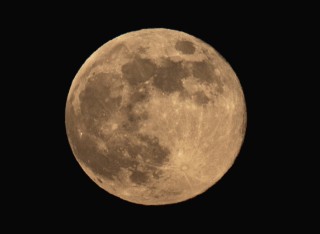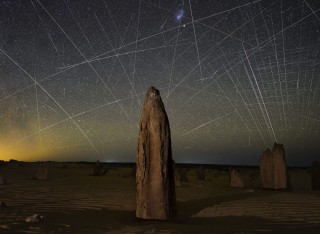
Dr Noelia E. D. Noël
Academic and research departments
School of Mathematics and Physics, Institute for Sustainability, Equality, diversity and inclusion.About
Biography
I come from a small Argentinean town located 800 km south of Buenos Aires. When I was five, my dad built a dome on top of her home's roof and put a telescope there. That's when I became interested in the Magellanic Clouds, our two closest irregular galaxies, seen as two ''Milky'' patches on the Southern skies.
After obtaining my Ph.D. in Astrophysics from the Instituto de Astrofisica de Canarias, I briefly worked as a Geophysicist. I later joined the Royal Observatory of Edinburgh as a Marie Curie postdoc, followed by a post as Research Scientist at the Max Planck Institute for Astronomy and, a postdoctoral position at the ETH Zürich.
I joined the Astrophysics group at the University of Surrey in 2013 as a Research Fellow and since 2016 I am a Lecturer in Astrophysics.
News
In the media
ResearchResearch interests
My research focuses on the study of resolved stellar populations in nearby galaxies.
The field of resolved stellar populations study of the ecology of stars -- connects the nature, variety, and number of stars with the environment in which they live. The key observable used is a plot of the colours versus the brightnesses of stars called the Colour Magnitude Diagram (CMD). Comparing the observed distribution of stars in the CMD with predictions from stellar evolution models, allows us to measure when, where, and how rapidly stars formed within a galaxy. We can determine which stars did not originate within the galaxy, having been most likely subsumed from a smaller companion galaxy in a galactic merger. And we can calculate how much gas must have been available, or accreted, in order to form these stars.
Resolving nearby stars is also very powerful in order to address the behaviour of extragalactic systems. The light we see from external galaxies comes from billions of unresolved stars. This galactic light encodes the entire history of a galaxy and, by fitting stellar models to this light, we can have a powerful probe of galaxy formation and evolution. In practice, this is hampered by our incomplete knowledge of how stars form and evolve. One way to make progress is to use nearby star clusters as templates to calibrate stellar evolution models. The clusters in the Magellanic Clouds, our nearest galaxies, are ideal since each star can be individually resolved. Comparing models with resolved star clusters is of key importance in order to calibrate the stellar population synthesis models and provide a better constrain for extragalactic studies.
Research interests
My research focuses on the study of resolved stellar populations in nearby galaxies.
The field of resolved stellar populations study of the ecology of stars -- connects the nature, variety, and number of stars with the environment in which they live. The key observable used is a plot of the colours versus the brightnesses of stars called the Colour Magnitude Diagram (CMD). Comparing the observed distribution of stars in the CMD with predictions from stellar evolution models, allows us to measure when, where, and how rapidly stars formed within a galaxy. We can determine which stars did not originate within the galaxy, having been most likely subsumed from a smaller companion galaxy in a galactic merger. And we can calculate how much gas must have been available, or accreted, in order to form these stars.
Resolving nearby stars is also very powerful in order to address the behaviour of extragalactic systems. The light we see from external galaxies comes from billions of unresolved stars. This galactic light encodes the entire history of a galaxy and, by fitting stellar models to this light, we can have a powerful probe of galaxy formation and evolution. In practice, this is hampered by our incomplete knowledge of how stars form and evolve. One way to make progress is to use nearby star clusters as templates to calibrate stellar evolution models. The clusters in the Magellanic Clouds, our nearest galaxies, are ideal since each star can be individually resolved. Comparing models with resolved star clusters is of key importance in order to calibrate the stellar population synthesis models and provide a better constrain for extragalactic studies.
Supervision
Postgraduate research supervision
Supervisor of Daphne Jackson Fellow Dr Susan Hutton
PGR supervision:
Dr Pol Massana (2017-2021)
Dr Michele De Leo (2018-2021)
Joanna Sakowska (2020-present)
Alex Goater (2020-present)
Mahdieh Navabi (2022-present)
Co-supervisor to:
Izzy Gray (2021-present)
Sustainable development goals
My research interests are related to the following:






Publications
This report describes the outcomes of a co-production workshop focused on inclusive training and guidance for writing narrative CVs, and includes a set of recommendations.
This report presents a study that analyses the language used by researchers in narrative CVs and examines how specific linguistic features influence reviewers' evaluations
THE PROJECT We conducted semi-structured interviews to identify the obstacles for underrepresented researchers while preparing their application and emphasise the good practices that support them. These interviews were part of a UKRI/BA EDI Caucus-funded project titled Breaking Barriers in Research Funding Applications: Evaluating Narrative CVs and Co-Designing Solutions for Application Processes. PARTICIPANTS Twenty underrepresented researchers—scholars who are minorities in academia due to factors such as gender, sexual orientation, ethnicity, disability, age, religion, socioeconomic background, migration status, language background, or intersecting characteristics. CONCEPT MAP & GLOSSARY The data informed the development of a concept map illustrating the barriers and facilitators to adopting Narrative CVs among underrepresented researchers, along with a glossary explaining each of these factors.
THE PROJECT We conducted semi-structured interviews to identify the obstacles for underrepresented researchers while preparing their application and emphasise the good practices that support them. These interviews were part of a UKRI/BA EDI Caucus-funded project titled Breaking Barriers in Research Funding Applications: Evaluating Narrative CVs and Co-Designing Solutions for Application Processes. PARTICIPANTS Twenty underrepresented researchers—scholars who are minorities in academia due to factors such as gender, sexual orientation, ethnicity, disability, age, religion, socioeconomic background, migration status, language background, or intersecting characteristics. CONCEPT MAP & GLOSSARY The data informed the development of a concept map illustrating the barriers and facilitators when preparing grant applications among underrepresented researchers, along with a glossary explaining each of these factors. Although distinct, self-related and external barriers interacted to exacerbate the difficulties faced by researchers from marginalised groups.
The current and next observation seasons will detect hundreds of gravitational waves (GWs) from compact binary systems coalescence at cosmological distances. When combined with independent electromagnetic measurements, the source redshift will be known, and we will be able to obtain precise measurements of the Hubble constant $H_0$ via the distance-redshift relation. However, most observed mergers are not expected to have electromagnetic counterparts, which prevents a direct redshift measurement. In this scenario, one of the possibilities is to use the dark sirens method that statistically marginalizes over all the potential host galaxies within the GW location volume to provide a probabilistic redshift to the source. Here we presented $H_{0}$ measurements using two new dark sirens compared to previous analyses using DECam data, GW190924$\_$021846 and GW200202$\_$154313. The photometric redshifts of the possible host galaxies of these two events are acquired from the DECam Local Volume Exploration Survey (DELVE) carried out on the Blanco telescope at Cerro Tololo in Chile. The combination of the $H_0$ posterior from GW190924$\_$021846 and GW200202$\_$154313 together with the bright siren GW170817 leads to $H_{0} = 68.84^{+15.51}_{-7.74}\, \rm{km/s/Mpc}$. Including these two dark sirens improves the 68% confidence interval (CI) by 7% over GW170817 alone. This demonstrates that the inclusion of well-localized dark sirens in such analysis improves the precision with which cosmological measurements can be made. Using a sample containing 10 well-localized dark sirens observed during the third LIGO/Virgo observation run, we determine a measurement of $H_{0} = 76.00^{+17.64}_{-13.45}\, \rm{km /s/Mpc}$.
We report the discovery of Pegasus IV, an ultra-faint dwarf galaxy found in archival data from the Dark Energy Camera processed by the DECam Local Volume Exploration Survey. Pegasus IV is a compact, ultra-faint stellar system ( r 1 / 2 = 41 − 6 + 8 pc; M V = −4.25 ± 0.2 mag) located at a heliocentric distance of 90 − 6 + 4 kpc . Based on spectra of seven nonvariable member stars observed with Magellan/IMACS, we confidently resolve Pegasus IV’s velocity dispersion, measuring σ v = 3.3 − 1.1 + 1.7 km s −1 (after excluding three velocity outliers); this implies a mass-to-light ratio of M 1 / 2 / L V , 1 / 2 = 167 − 99 + 224 M ⊙ / L ⊙ for the system. From the five stars with the highest signal-to-noise spectra, we also measure a systemic metallicity of [Fe/H] = − 2.63 − 0.30 + 0.26 dex, making Pegasus IV one of the most metal-poor ultra-faint dwarfs. We tentatively resolve a nonzero metallicity dispersion for the system. These measurements provide strong evidence that Pegasus IV is a dark-matter-dominated dwarf galaxy, rather than a star cluster. We measure Pegasus IV’s proper motion using data from Gaia Early Data Release 3, finding ( μ α * , μ δ ) = (0.33 ± 0.07, −0.21 ± 0.08) mas yr −1 . When combined with our measured systemic velocity, this proper motion suggests that Pegasus IV is on an elliptical, retrograde orbit, and is currently near its orbital apocenter. Lastly, we identify three potential RR Lyrae variable stars within Pegasus IV, including one candidate member located more than 10 half-light radii away from the system’s centroid. The discovery of yet another ultra-faint dwarf galaxy strongly suggests that the census of Milky Way satellites is still incomplete, even within 100 kpc.
Abstract We present a spectroscopic analysis of Eridanus IV (Eri IV) and Centaurus I (Cen I), two ultrafaint dwarf galaxies of the Milky Way. Using IMACS/Magellan spectroscopy, we identify 28 member stars of Eri IV and 34 member stars of Cen I. For Eri IV, we measure a systemic velocity of v sys = − 31.5 − 1.2 + 1.3 km s − 1 , and velocity dispersion σ v = 6.1 − 0.9 + 1.2 km s − 1 . Additionally, we measure the metallicities of 16 member stars of Eri IV. We find a metallicity of [ Fe / H ] = − 2.87 − 0.07 + 0.08 , and resolve a dispersion of σ [Fe/H] =0.20 ± 0.09. The mean metallicity is marginally lower than all other known ultrafaint dwarf galaxies, making it one of the most metal-poor galaxies discovered thus far. Eri IV also has a somewhat unusual right-skewed metallicity distribution. For Cen I, we find a velocity v sys = 44.9 ± 0.8 km s −1 , and velocity dispersion σ v = 4.2 − 0.5 + 0.6 km s − 1 . We measure the metallicities of 27 member stars of Cen I, and find a mean metallicity [Fe/H] = −2.57 ± 0.08, and metallicity dispersion σ [ Fe / H ] = 0.38 − 0.05 + 0.07 . We calculate the systemic proper motion, orbit, and the astrophysical J-factor for each system, the latter of which indicates that Eri IV is a good target for indirect dark matter detection. We also find no strong evidence for tidal stripping of Cen I or Eri IV. Overall, our measurements confirm that Eri IV and Cen I are dark-matter-dominated galaxies with properties largely consistent with other known ultrafaint dwarf galaxies. The low metallicity, right-skewed metallicity distribution, and high J-factor make Eri IV an especially interesting candidate for further follow-up.
The DECam Local Volume Exploration survey (DELVE) is a 126-night survey program on the 4 m Blanco Telescope at the Cerro Tololo Inter-American Observatory in Chile. DELVE seeks to understand the characteristics of faint satellite galaxies and other resolved stellar substructures over a range of environments in the Local Volume. DELVE will combine new DECam observations with archival DECam data to cover similar to 15,000 deg(2) of high Galactic latitude (vertical bar b vertical bar > 10 degrees) southern sky to a 5 sigma depth of g, r, i, z similar to 23.5 mag. In addition, DELVE will cover a region of similar to 2200 deg(2) around the Magellanic Clouds to a depth of g, r, i similar to 24.5 mag and an area of similar to 135 deg(2) around four Magellanic analogs to a depth of g, i similar to 25.5 mag. Here, we present an overview of the DELVE program and progress to date. We also summarize the first DELVE public data release (DELVE DR1), which provides point-source and automatic aperture photometry for similar to 520 million astronomical sources covering similar to 5000 deg(2) of the southern sky to a 5 sigma point-source depth of g = 24.3 mag, r = 23.9 mag, i = 23.3 mag, and z = 22.8 mag. DELVE DR1 is publicly available via the NOIRLab Astro Data Lab science platform.
ABSTRACT We obtain a quantitative star formation history (SFH) of a shell-like structure (‘shell’) located in the northeastern part of the Small Magellanic Cloud (SMC). We use the Survey of the MAgellanic Stellar History to derive colour–magnitude diagrams (CMDs), reaching below the oldest main-sequence turnoff, from which we compute the SFHs with CMD-fitting techniques. We present, for the first time, a novel technique that uses red clump (RC) stars from the CMDs to assess and account for the SMC’s line-of-sight depth effect present during the SFH derivation. We find that accounting for this effect recovers a more accurate SFH. We quantify an $\sim$7 kpc line-of-sight depth present in the CMDs, in good agreement with depth estimates from RC stars in the northeastern SMC. By isolating the stellar content of the northeastern shell and incorporating the line-of-sight depth into our calculations, we obtain an unprecedentedly detailed SFH. We find that the northeastern shell is primarily composed of stars younger than $\sim$500 Myr, with significant star formation enhancements around $\sim$250 and $\sim$450 Myr. These young stars are the main contributors to the shell’s structure. We show synchronicity between the northeastern shell’s SFH with the Large Magellanic Cloud’s (LMC) northern arm, which we attribute to the interaction history of the SMC with the LMC and the Milky Way (MW) over the past $\sim$500 Myr. Our results highlight the complex interplay of ram pressure stripping and the influence of the MW’s circumgalactic medium in shaping the SMC’s northeastern shell.
We report the discovery of six ultra-faint Milky Way satellites identified through matched-filter searches conducted using Dark Energy Camera (DECam) data processed as part of the second data release of the DECam Local Volume Exploration (DELVE) survey. Leveraging deep Gemini/GMOS-N imaging (for four candidates) as well as follow-up DECam imaging (for two candidates), we characterize the morphologies and stellar populations of these systems. We find that these candidates all share faint absolute magnitudes (M ( V ) & GE; -3.2 mag) and old, metal-poor stellar populations (& tau; > 10 Gyr, [Fe/H] < -1.4 dex). Three of these systems are more extended (r (1/2) > 15 pc), while the other three are compact (r (1/2) < 10 pc). From these properties, we infer that the former three systems (Bootes V, Leo Minor I, and Virgo II) are consistent with ultra-faint dwarf galaxy classifications, whereas the latter three (DELVE 3, DELVE 4, and DELVE 5) are likely ultra-faint star clusters. Using data from the Gaia satellite, we confidently measure the proper motion of Bootes V, Leo Minor I, and DELVE 4, and tentatively detect a proper-motion signal from DELVE 3 and DELVE 5; no signal is detected for Virgo II. We use these measurements to explore possible associations between the newly discovered systems and the Sagittarius dwarf spheroidal, the Magellanic Clouds, and the Vast Polar Structure, finding several plausible associations. Our results offer a preview of the numerous ultra-faint stellar systems that will soon be discovered by the Vera C. Rubin Observatory and highlight the challenges of classifying the faintest stellar systems.
The Large and Small Magellanic Clouds (LMC and SMC) are the largest satellite galaxies of the Milky Way and close enough to allow for a detailed exploration of their structure and formation history. The Survey of the MAgellanic Stellar History (SMASH) is a community Dark Energy Camera (DECam) survey of the Magellanic Clouds using ~50 nights to sample over ~2400 deg2 centered on the Clouds at ~20% filling factor (but with contiguous coverage in the central regions) and to depths of ~24th mag in ugriz. The primary goals of SMASH are to map out the extended stellar peripheries of the Clouds and uncover their complicated interaction and accretion history as well as to derive spatially resolved star formation histories of the central regions and create a "movie" of their past star formation. Here we announce the second SMASH public data release (DR2), which contains all 197 fully calibrated DECam fields including the main body fields in the central regions. The DR2 data are available through the Astro Data Lab hosted by the NSF's National Optical-Infrared Astronomy Research Laboratory. We highlight three science cases that make use of the SMASH DR2 data and will be published in the future: (1) preliminary star formation histories of the LMC, (2) the search for Magellanic star clusters using citizen scientists, and, (3) photometric metallicities of Magellanic Cloud stars using the DECam u-band.
We use the SMASH survey to obtain unprecedented deep photometry reaching down to the oldest main sequence turn-offs in the colour-magnitude diagrams (CMDs) of the Small Magellanic Cloud (SMC) and quantitatively derive its star formation history (SFH) using CMD fitting techniques. We identify five distinctive peaks of star formation in the last 3.5 Gyr, at $\sim $3, $\sim$2, $\sim$1.1, $\sim $0.45 Gyr ago, and one presently. We compare these to the SFH of the Large Magellanic Cloud (LMC) finding unequivocal synchronicity, with both galaxies displaying similar periods of enhanced star formation over the past $\sim$3.5 Gyr. The parallelism between their SFHs indicates that tidal interactions between the MCs have recurrently played an important role in their evolution for at least the last $\sim$3.5 Gyr, tidally truncating the SMC and shaping the LMC's spiral arm. We show, for the first time, an SMC-LMC correlated SFH at recent times in which enhancements of star formation are localised in the northern spiral arm of the LMC, and globally across the SMC. These novel findings should be used to constrain not only the orbital history of the MCs but also how star formation should be treated in simulations.
We present the second public data release (DR2) from the DECam Local Volume Exploration survey (DELVE). DELVE DR2 combines new DECam observations with archival DECam data from the Dark Energy Survey, the DECam Legacy Survey, and other DECam community programs. DELVE DR2 consists of ~160,000 exposures that cover >21,000 deg^2 of the high Galactic latitude (|b| > 10 deg) sky in four broadband optical/near-infrared filters (g, r, i, z). DELVE DR2 provides point-source and automatic aperture photometry for ~2.5 billion astronomical sources with a median 5{\sigma} point-source depth of g=24.3, r=23.9, i=23.5, and z=22.8 mag. A region of ~17,000 deg^2 has been imaged in all four filters, providing four-band photometric measurements for ~618 million astronomical sources. DELVE DR2 covers more than four times the area of the previous DELVE data release and contains roughly five times as many astronomical objects. DELVE DR2 is publicly available via the NOIRLab Astro Data Lab science platform.
We report the discovery of Pegasus IV, an ultra-faint dwarf galaxy found in archival data from the Dark Energy Camera processed by the DECam Local Volume Exploration Survey. Pegasus IV is a compact, ultra-faint stellar system ($r_{1/2} = 41^{+8}_{-6}$ pc; $M_V = -4.25 \pm 0.2$ mag) located at a heliocentric distance of $90^{+4}_{-6}$ kpc. Based on spectra of seven non-variable member stars observed with Magellan/IMACS, we confidently resolve Pegasus IV's velocity dispersion, measuring $\sigma_{v} = 3.3^{+1.7}_{-1.1} \text{ km s}^{-1}$ (after excluding three velocity outliers); this implies a mass-to-light ratio of $M_{1/2}/L_{V,1/2} = 167^{+224}_{-99} M_{\odot}/L_{\odot}$ for the system. From the five stars with the highest signal-to-noise spectra, we also measure a systemic metallicity of $\rm [Fe/H] = -2.67^{+0.25}_{-0.29}$ dex, making Pegasus IV one of the most metal-poor ultra-faint dwarfs. We tentatively resolve a non-zero metallicity dispersion for the system. These measurements provide strong evidence that Pegasus IV is a dark-matter-dominated dwarf galaxy, rather than a star cluster. We measure Pegasus IV's proper motion using data from Gaia Early Data Release 3, finding ($\mu_{\alpha*}, \mu_{\delta}) = (0.33\pm 0.07, -0.21 \pm 0.08) \text{ mas yr}^{-1}$. When combined with our measured systemic velocity, this proper motion suggests that Pegasus IV is on an elliptical, retrograde orbit, and is currently near its orbital apocenter. Lastly, we identify three potential RR Lyrae variable stars within Pegasus IV, including one candidate member located more than ten half-light radii away from the system's centroid. The discovery of yet another ultra-faint dwarf galaxy strongly suggests that the census of Milky Way satellites is still incomplete, even within 100 kpc.
We report the discovery of two ultra-faint stellar systems found in early data from the DECam Local Volume Exploration survey (DELVE). The rst system, Centaurus I (DELVE J1238
We present the discovery of a very faint stellar system, SMASH 1, that is potentially a satellite of the Large Magellanic Cloud. Found within the Survey of the Magellanic Stellar History (SMASH), SMASH 1 is a compact (${r}_{h}={9.1}_{-3.4}^{+5.9}____,____mathrm{pc}$) and very low luminosity (${M}_{V}=-1.0____pm 0.9$, ${L}_{V}={10}^{2.3____pm 0.4}____,{L}_{____odot }$) stellar system that is revealed by its sparsely populated main sequence and a handful of red giant branch candidate member stars. The photometric properties of these stars are compatible with a metal-poor ($[____mathrm{Fe}/{____rm{H}}]=-2.2$) and old (13 Gyr) isochrone located at a distance modulus of ~18.8, i.e., a distance of $____sim 57____,____mathrm{kpc}$. Situated at 11fdg3 from the LMC in projection, its three-dimensional distance from the Cloud is $____sim 13____,____mathrm{kpc}$, consistent with a connection to the LMC, whose tidal radius is at least $16____,____mathrm{kpc}$. Although the nature of SMASH 1 remains uncertain, its compactness favors it being a stellar cluster and hence dark-matter free. If this is the case, its dynamical tidal radius is only $____lesssim 19____,____mathrm{pc}$ at this distance from the LMC, and smaller than the system's extent on the sky. Its low luminosity and apparent high ellipticity ($____epsilon ={0.62}_{-0.21}^{+0.17}$) with its major axis pointing toward the LMC may well be the tell-tale sign of its imminent tidal demise.
We report a new ultra-faint stellar system found in Dark Energy Camera data from the first observing run of the Magellanic Satellites Survey (MagLiteS). MagLiteS J0644−5953 (Pictor II or Pic II) is a low surface brightness (N 28.5 mag arcsec 1 1 2 within its half-light radius) resolved overdensity of old and metal-poor stars located at a heliocentric distance of 45 kpc 4 5 . The physical size ( r1 2 46 pc 11 15 ) and low luminosity ( M V 3.2 mag 0.5 0.4 ) of this satellite are consistent with the locus of spectroscopically confirmed ultra-faint galaxies. MagLiteS J0644−5953 (Pic II) is located 11.3 kpc 0.9 3.1 from the Large Magellanic Cloud (LMC), and comparisons with simulation results in the literature suggest that this satellite was likely accreted with the LMC. The close proximity of MagLiteS J0644−5953 (Pic II) to the LMC also makes it the most likely ultra-faint galaxy candidate to still be gravitationally bound to the LMC.
The Magellanic Bridge (MB) is a gaseous stream that links the Large (LMC) and Small (SMC) Magellanic Clouds. Current simulations suggest that the MB forms from a recent interaction between the Clouds. In this scenario, the MB should also have an associated stellar bridge formed by stars tidally stripped from the SMC by the LMC. There are several observational evidences for these stripped stars, from the presence of intermediate age populations in the MB and carbon stars, to the recent observation of an over-density of RR Lyrae stars offset from the MB. However, spectroscopic confirmation of stripped stars in the MB remains lacking. In this paper, we use medium resolution spectra to derive the radial velocities and metallicities of stars in two fields along the MB. We show from both their chemistry and kinematics that the bulk of these stars must have been tidally stripped from the SMC. This is the first spectroscopic evidence for a dwarf galaxy being tidally stripped by a larger dwarf.
The periphery of the Small Magellanic Cloud (SMC) can unlock important information regarding galaxy formation and evolution in interacting systems. Here, we present a detailed study of the extended stellar structure of the SMC using deep colour–magnitude diagrams, obtained as part of the Survey of the MAgellanic Stellar History (SMASH). Special care was taken in the decontamination of our data from Milky Way (MW) foreground stars, including from foreground globular clusters NGC 362 and 47 Tuc. We derived the SMC surface brightness using a ‘conservative’ approach from which we calculated the general parameters of the SMC, finding a staggered surface brightness profile. We also traced the fainter outskirts by constructing a stellar density profile. This approach, based on stellar counts of the oldest main-sequence turn-off stars, uncovered a tidally disrupted stellar feature that reaches as far out as 12 deg from the SMC centre. We also serendipitously found a faint feature of unknown origin located at ∼14 deg from the centre of the SMC and that we tentatively associated with a more distant structure. We compared our results to in-house simulations of a 1 × 109 M⊙ SMC, finding that its elliptical shape can be explained by its tidal disruption under the combined presence of the MW and the Large Magellanic Cloud. Finally, we found that the older stellar populations show a smooth profile while the younger component presents a jump in the density followed by a flat profile, confirming the heavily disturbed nature of the SMC.
We present a map of the total intrinsic reddening across ≃34 deg2 of the Small Magellanic Cloud (SMC) derived using optical (ugriz) and near-infrared (IR; YJKs) spectral energy distributions (SEDs) of background galaxies. The reddening map is created using a subsample of 29 274 galaxies with low levels of intrinsic reddening based on the LEPHARE χ2 minimization SED-fitting routine. We find statistically significant enhanced levels of reddening associated with the main body of the SMC compared with regions in the outskirts [ΔE(B − V) ≃ 0.3 mag]. A comparison with literature reddening maps of the SMC shows that, after correcting for differences in the volume of the SMC sampled, there is good agreement between our results and maps created using young stars. In contrast, we find significant discrepancies between our results and maps created using old stars or based on longer wavelength far-IR dust emission that could stem from biased samples in the former and uncertainties in the far-IR emissivity and the optical properties of the dust grains in the latter. This study represents one of the first large-scale categorizations of extragalactic sources behind the SMC and as such we provide the LEPHARE outputs for our full sample of ∼500 000 sources.
We report the discovery of two ultra-faint satellites in the vicinity of the Large Magellanic Cloud (LMC) in data from the Magellanic Satellites Survey (MagLiteS ). Situated 18 deg (∼20 kpc) from the LMC and separated from each other by only 18 arcmin, Carina II and III form an intriguing pair. By simultaneously modelling the spatial and the colour–magnitude stellar distributions, we find that both Carina II and Carina III are likely dwarf galaxies, although this is less clear for Carina III. There are in fact several obvious differences between the two satellites. While both are well described by an old and metal poor population, Carina II is located at ∼36 kpc from the Sun, with MV ∼ −4.5 and rh ∼ 90 pc, and it is further confirmed by the discovery of 3 RR Lyrae at the right distance. In contrast, Carina III is much more elongated, measured to be fainter (MV ∼ −2.4), significantly more compact (rh ∼ 30 pc), and closer to the Sun, at ∼28 kpc, placing it only 8 kpc away from Car II. Together with several other systems detected by the Dark Energy Camera, Carina II and III form a strongly anisotropic cloud of satellites in the vicinity of the Magellanic Clouds.
Context. Understanding the evolutionary history of the Magellanic Clouds requires an in-depth exploration and characterization of the stellar content in their outer regions, which ultimately are key to tracing the epochs and nature of past interactions. Aims. We present new deep images of a shell-like overdensity of stars in the outskirts of the Small Magellanic Cloud (SMC). The shell, also detected in photographic plates dating back to the fifties, is located at ∼1.9° from the center of the SMC in the north-east direction. Methods. The structure and stellar content of this feature were studied with multiband, optical data from the Survey of the MAgellanic Stellar History (SMASH) carried out with the Dark Energy Camera on the Blanco Telescope at Cerro Tololo Inter-American Observatory. We also investigate the kinematic of the stars in the shell using the Gaia Data Release 2. Results. The shell is composed of a young population with an age ∼150 Myr, with no contribution from an old population. Thus, it is hard to explain its origin as the remnant of a tidally disrupted stellar system. The spatial distribution of the young main-sequence stars shows a rich sub-structure, with a spiral arm-like feature emanating from the main shell and a separated small arc of young stars close to the globular cluster NGC 362. We find that the absolute g-band magnitude of the shell is Mg, shell = −10.78 ± 0.02, with a surface brightness of μg, shell = 25.81 ± 0.01 mag arcsec−2. Conclusion. We have not found any evidence that this feature is of tidal origin or a bright part of a spiral arm-like structure. Instead, we suggest that the shell formed in a recent star formation event, likely triggered by an interaction with the Large Magellanic Cloud and or the Milky Way, ∼150 Myr ago.
We present a map of the total intrinsic reddening across similar or equal to 90 deg(2) of the Large Magellanic Cloud (LMC) derived using optical (ugriz) and near-infrared (IR; YJK(s)) spectral energy distributions (SEDs) of background galaxies. The reddening map is created from a sample of 222 752 early-type galaxies based on the lephare chi(2) minimization SED-fitting routine. We find excellent agreement between the regions of enhanced intrinsic reddening across the central (4 x 4 deg(2)) region of the LMC and the morphology of the low-level pervasive dust emission as traced by far-IR emission. In addition, we are able to distinguish smaller, isolated enhancements that are coincident with known star-forming regions and the clustering of young stars observed in morphology maps. The level of reddening associated with the molecular ridge south of 30 Doradus is, however, smaller than in the literature reddening maps. The reduced number of galaxies detected in this region, due to high extinction and crowding, may bias our results towards lower reddening values. Our map is consistent with maps derived from red clump stars and from the analysis of the star formation history across the LMC. This study represents one of the first large-scale categorizations of extragalactic sources behind the LMC and as such we provide the lephare outputs for our full sample of similar to 2.5 million sources.
Due to their close proximity, the Large and Small Magellanic Clouds (LMC/SMC) provide natural laboratories for understanding how galaxies form and evolve. With the goal of determining the structure and dynamical state of the SMC, we present new spectroscopic data for ∼3000 SMC red giant branch stars observed using the AAOmega spectrograph at the Anglo-Australian Telescope. We complement our data with further spectroscopic measurements from previous studies that used the same instrumental configuration as well as proper motions from the Gaia Data Release 2 catalogue. Analysing the photometric and stellar kinematic data, we find that the SMC centre of mass presents a conspicuous offset from the velocity centre of its associated H i gas, suggesting that the SMC gas is likely to be far from dynamical equilibrium. Furthermore, we find evidence that the SMC is currently undergoing tidal disruption by the LMC within 2 kpc of the centre of the SMC, and possibly all the way into the very core. This is revealed by a net outward motion of stars from the SMC centre along the direction towards the LMC and an apparent tangential anisotropy at all radii. The latter is expected if the SMC is undergoing significant tidal stripping, as we demonstrate using a suite of N-body simulations of the SMC/LMC system disrupting around the Milky Way. Our results suggest that dynamical models for the SMC that assume a steady state will need to be revisited.
We report the discovery of a stellar overdensity 8° north of the centre of the Small Magellanic Cloud (SMC; Small Magellanic Cloud Northern Over-Density; SMCNOD), using data from the first 2 yr of the Dark Energy Survey (DES) and the first year of the MAGellanic SatelLITEs Survey (MagLiteS). The SMCNOD is indistinguishable in age, metallicity and distance from the nearby SMC stars, being primarily composed of intermediate-age stars (6 Gyr, Z=0.001), with a small fraction of young stars (1 Gyr, Z=0.01). The SMCNOD has an elongated shape with an ellipticity of 0.6 and a size of ∼ 6° × 2°. It has an absolute magnitude of MV ≅ −7.7, rh = 2.1 kpc, and μV(r < rh) = 31.2 mag arcsec−2. We estimate a stellar mass of ∼105 M⊙, following a Kroupa mass function. The SMCNOD was probably removed from the SMC disc by tidal stripping, since it is located near the head of the Magellanic Stream, and the literature indicates likely recent Large Magellanic Cloud-SMC encounters. This scenario is supported by the lack of significant H I gas. Other potential scenarios for the SMCNOD origin are a transient overdensity within the SMC tidal radius or a primordial SMC satellite in advanced stage of disruption.
The optical integrated spectra of three Large Magellanic Cloud young stellar clusters (NGC 1984, NGC 1994 and NGC 2011) exhibit concave continua and prominent molecular bands which deviate significantly from the predictions of single stellar population (SSP) models. In order to understand the appearance of these spectra, we create a set of young stellar population (MILES) models, which we make available to the community. We use archival International Ultraviolet Explorer integrated UV spectra to independently constrain the cluster masses and extinction, and rule out strong stochastic effects in the optical spectra. In addition, we also analyse deep colour–magnitude diagrams of the clusters to provide independent age determinations based on isochrone fitting. We explore hypotheses, including age spreads in the clusters, a top-heavy initial mass function, different SSP models and the role of red supergiant stars (RSG). We find that the strong molecular features in the optical spectra can be only reproduced by modelling an increased fraction of about ∼20 per cent by luminosity of RSG above what is predicted by canonical stellar evolution models. Given the uncertainties in stellar evolution at Myr ages, we cannot presently rule out the presence of Myr age spreads in these clusters. Our work combines different wavelengths as well as different approaches (resolved data as well as integrated spectra for the same sample) in order to reveal the complete picture. We show that each approach provides important information but in combination we can better understand the cluster stellar populations.
The Large and Small Magellanic Clouds are unique local laboratories for studying the formation and evolution of small galaxies in exquisite detail. The Survey of the MAgellanic Stellar History (SMASH) is an NOAO community Dark Energy Camera (DECam) survey of the Clouds mapping 480 deg2 (distributed over ~2400 square degrees at ~20% filling factor) to ~24th mag in ugriz. The primary goals of SMASH are to identify low surface brightness stellar populations associated with the stellar halos and tidal debris of the Clouds, and to derive spatially resolved star formation histories. Here, we present a summary of the survey, its data reduction, and a description of the first public Data Release (DR1). The SMASH DECam data have been reduced with a combination of the NOAO Community Pipeline, the PHOTRED automated point-spread-function photometry pipeline, and custom calibration software. The astrometric precision is ~15 mas and the accuracy is ~2 mas with respect to the Gaia reference frame. The photometric precision is ~0.5%–0.7% in griz and ~1% in u with a calibration accuracy of ~1.3% in all bands. The median 5σ point source depths in ugriz are 23.9, 24.8, 24.5, 24.2, and 23.5 mag. The SMASH data have already been used to discover the Hydra II Milky Way satellite, the SMASH 1 old globular cluster likely associated with the LMC, and extended stellar populations around the LMC out to R ~ 18.4 kpc. SMASH DR1 contains measurements of ~100 million objects distributed in 61 fields. A prototype version of the NOAO Data Lab provides data access and exploration tools.
We explore the stellar structure of the Large Magellanic Cloud (LMC) disk using data from the Survey of the MAgellanic Stellar History and the Dark Energy Survey. We detect a ring-like stellar overdensity in the red clump star count map at a radius of ~6° (~5.2 kpc at the LMC distance) that is continuous over ~270° in position angle and is only limited by the current data coverage. The overdensity shows an amplitude up to 2.5 times higher than that of the underlying smooth disk. This structure might be related to the multiple arms found by de Vaucouleurs. We find that the overdensity shows spatial correlation with intermediate-age star clusters, but not with young (
We report the discovery of two ultra-faint satellites in the vicinity of the Large Magellanic Cloud (LMC) in data from the Magellanic Satellites Survey (MagLiteS ). Situated 18 deg (∼20 kpc) from the LMC and separated from each other by only 18 arcmin, Carina II and III form an intriguing pair. By simultaneously modelling the spatial and the colour–magnitude stellar distributions, we find that both Carina II and Carina III are likely dwarf galaxies, although this is less clear for Carina III. There are in fact several obvious differences between the two satellites. While both are well described by an old and metal poor population, Carina II is located at ∼36 kpc from the Sun, with MV ∼ −4.5 and rh ∼ 90 pc, and it is further confirmed by the discovery of 3 RR Lyrae at the right distance. In contrast, Carina III is much more elongated, measured to be fainter (MV ∼ −2.4), significantly more compact (rh ∼ 30 pc), and closer to the Sun, at ∼28 kpc, placing it only 8 kpc away from Car II. Together with several other systems detected by the Dark Energy Camera, Carina II and III form a strongly anisotropic cloud of satellites in the vicinity of the Magellanic Clouds.





